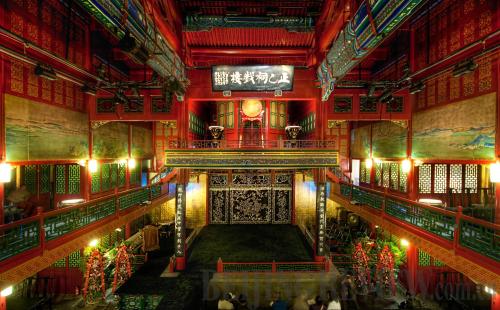|
 |
|
ANTIQUE HALL: The Zheng Yi Ci Theater maintains its traditional decoration and structure of an ancient Chinese theater with a history of over 300 years (COURTESY OF YANG SISI) |
Beijing has a history of over 1,000 years. There were once many renowned traditional Chinese opera theaters in the capital city. But now these vintage theaters are being swallowed up in the glitz of modernization and urbanization. Nevertheless, people can still make unexpected discoveries of traditional Chinese culture when wandering through Beijing's hutongs, or alleys. The Zheng Yi Ci Theater is one such surprise. It is a historical relic with over 300 years of history, poised to reinvigorate the traditional Chinese opera.
Xinhuayaji International Cultural Communication Co. Ltd. produced the 2011 Winter Drama Season at the Zheng Yi Ci Theater from November 23 to December 25, 2011, reigniting the fame of the oldest theater in Beijing. The Zheng Yi Ci served as the venue for the 100th production of the Mei Lanfang Classics, a six-part production by the eponymous Peking Opera master. This year will mark the 300th anniversary of the theater's reconstruction.
"We hope to attract more people to watch traditional opera and care for the ancient theater through the drama season," said Yang Xiaolin, Vice President of Xinhuayaji. "Traditional Peking Opera and the Zheng Yi Ci Theater are the brilliant heritage of our ancestors. Traditional Chinese stage art and antique theaters must find new ways to attract wider audiences to be revived in modern cities."
In addition to Mei Lanfang Classics, the theater has introduced several experimental contemporary dramas. Because of the traditional stage condition and unique layout of the theater, directors and artists had to adapt their plays to accommodating the vintage architecture, which lends a mysterious atmosphere to the performance.
Twists and turns
For traditional theaters of Beijing, there is no lack of interesting stories or splendid history. However, most theaters have fallen into obscurity with the coming of the information age. Some have moved to better-equipped buildings such as the Chang'an Grand Theater; others accept investment and diversify to provide additional services such as catering and event hosting, such as the Huguang and Yangping Guild Halls. But the Zheng Yi Ci Theater underwent even more twists and turns on the way toward its reopening.
The Zheng Yi Ci Theater was built earlier than many famous opera houses in the West, such as La Comédie Française in Paris (constructed in 1680) and the Royal Opera House in London (built in 1732). The theater was originally constructed as a temple during the Ming Dynasty (1368-1644). In 1667, during the Qing Dynasty (1644-1911), merchants from Zhejiang Province bought the temple to enshrine the god of wealth. In 1712, it was rebuilt and expanded, becoming a center of commerce. The opera house, at that time an auxiliary feature of the architectural complex, composed only one sixth of the total area.
| 